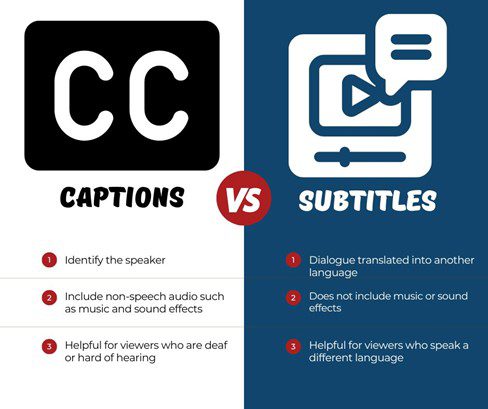
Closed Captioning vs Subtitles Differences & When to Use To Use Them
在上传视频、创建在线课程或运营社交媒体内容的过程中,我们经常会遇到“字幕”和“隐藏式字幕”这两个选项。许多人认为它们只是名称不同,功能大同小异。但实际上,这两种字幕在用途、受众和法律合规要求方面存在显著差异。.
随着全球内容分发、无障碍合规性和多语言字幕输出变得越来越重要,了解真正的差异并为内容需求选择合适的字幕格式已成为专业创作者和内容团队的必备技能。.
本文将深入分析字幕和隐藏式字幕的定义、区别及应用场景。结合我们在Easysub平台上的实践经验,本文将帮助您在最短的时间内掌握如何为您的内容选择合适、专业且平台兼容的字幕解决方案。.
随着视频发行日益全球化,字幕已成为帮助观众跨越语言障碍、提升观看体验的重要工具。那么,字幕究竟是什么?它的明确功能和范围又是什么?
字幕是将视频中说话者的语音内容以文字形式显示在屏幕上。它主要用于帮助观众理解视频中的语音内容。字幕通常不包含背景音效和非语言线索等辅助信息。其主要目标用户群体包括:
例子如果您在 Netflix 上观看韩剧或日剧时选择“英文字幕”,您将看到字幕。.
常见的字幕格式包括:
专业字幕工具(例如 Easysub) 通常通过人工智能语音识别(ASR)+自然语言处理(NLP)技术自动将音频转换为文本,并通过时间码对齐生成标准字幕文件,支持多语言输出和格式导出。.
为什么字幕如此重要?字幕可以帮助听障人士更好地理解视频内容。即使没有听障,观众也可能出于各种原因需要阅读字幕(例如通勤、会议、安静的环境)。.
此外,对于独立发布者而言,字幕可以提升视频的搜索引擎优化(SEO)。带有字幕的文本内容可以被搜索引擎索引,从而增加视频被找到的几率。.
虽然我们经常提到“字幕”,” 隐藏式字幕 (CC)与传统的字幕并不完全相同。传统的字幕起源于电视广播行业,旨在满足听障人士的信息获取需求。而隐藏式字幕(Closed Captioning)的出现,正是为了回应听障人士获取信息的需求。它不仅仅是“对话的文本版本”,更是一种强调无障碍性的字幕标准。.
在许多国家(尤其是美国),字幕是法律强制要求的。对于任何内容创作者、教育机构或企业来说,了解什么是隐藏式字幕、它与字幕的区别以及它的适用场景都至关重要。.
隐藏式字幕(CC)是指一种为听障人士设计的视频辅助文本系统。与普通字幕不同,CC不仅包含视频中的对话,还包含任何可能干扰理解的非语言信息。例如:
它的核心任务并非翻译语言,而是完整地传递视频中的所有音频信息,确保听障人士即使没有声音也能“听到”整个视频。.
作为一名专业的字幕员 人工智能工具, Easysub不仅支持传统字幕输出,而且完全兼容CC要求:
Easysub 为需要遵守监管要求、提高内容包容性以及服务特殊人群的创作者和组织提供可控、合规且易于使用的隐藏式字幕解决方案。.
虽然许多人认为‘字幕’和‘隐藏式字幕’是同一个概念,但实际上,从技术定义、适用人群到合规要求,它们之间存在着根本性的差异。.
| 对比项目 | 字幕 | 隐藏式字幕(CC) |
|---|---|---|
| 功能 | 为非母语听众翻译演讲 | 为听障用户转录所有音频内容 |
| 内容范围 | 仅显示对话(原声或翻译版) | 包含对话、音效、背景噪音和语气描述 |
| 目标用户 | 全球观众,非母语人士 | 聋人或听力障碍观众 |
| 开关 | 通常是固定的或硬编码的(尤其是开放式字幕) | 可切换开启/关闭(隐藏式字幕) |
| 法律要求 | 可选,取决于平台/用户 | 通常出于法律要求(FCC、ADA、教育/政府内容) |
| 格式支持 | 常见的: .srt, .vtt, .。屁股 | 还支持 .srt, .vtt, 但包含非语言元素 |
| 最佳用例 | 非常适合多语言视频发布 | 非常适合用于合规性、无障碍访问、教育和企业内容 |
推荐:
了解了字幕和隐藏式字幕的区别后,很多用户会问:那我应该用哪一个呢?实际上,选择哪种字幕格式不仅取决于观众是谁,还与您的内容类型、分发平台、法律法规、语言要求以及其他因素密切相关。.
In the actual production, you don’t need to judge the complexity of formatting, tools, language compatibility, etc. individually. 使用 Easysub,您可以:
随着视频内容在不同平台上的广泛传播,了解每个平台对字幕格式(隐藏式字幕和普通字幕)的支持能力已成为视频创作者和内容管理者的基本知识之一。.
Different platforms differ in terms of subtitle uploading, automatic recognition, format compatibility and language support. When it comes to international distribution, advertising compliance, and educational content distribution, if the subtitle format doesn’t meet the platform’s requirements, it will directly affect the efficiency of content uploading, viewing experience, and even trigger policy violations.
| 平台 | CC 支持 | 字幕支持 | 自动生成的字幕 | 多语言支持 | 上传字幕文件 | Easysub 的最佳格式 |
|---|---|---|---|---|---|---|
| YouTube | ✅ 是的 | ✅ 是的 | ✅ 是的 | ✅ 是的 | ✅ .srt, .vtt | ✅ 完全兼容 |
| Vimeo | ✅ 是的 | ✅ 是的 | ❌ 否 | ✅ 是的 | ✅ .vtt | ✅ 使用 .vtt 格式 |
| TikTok | ⚠️ 有限 | ✅ 是的 | ✅ 简易自动字幕 | ❌ 不支持多语言 | ❌ 不支持 | ✅ 使用开放式字幕 |
| ✅ 是的 | ✅ 是的 | ✅ 基本自动字幕 | ⚠️ 有限 | ✅ .srt | ✅ 使用 .srt 格式 | |
| Netflix | ✅ 必填 | ✅ 是的 | ❌ 否 | ✅ 全力支持 | ✅ 符合配送要求 | ✅ 支持专业版导出 |
| Coursera / edX | ✅ 必填 | ✅ 是的 | ❌仅限手动操作 | ✅ 是的 | ✅ .srt, .vtt | ✅强烈推荐 |
在了解了字幕和隐藏式字幕的区别、应用场景和平台支持之后,许多内容创作者、教育机构和企业用户都面临着一个实际问题:有哪些工具可以用来高效、准确且经济地制作字幕?
Easysub,作为一个 自动字幕生成工具 这款字幕工具由专业人工智能技术驱动,旨在解决这些痛点。与其他字幕工具相比,它不仅具备多语言识别、多格式输出等常规功能,而且在准确性、速度、可编辑性、翻译能力、无障碍兼容性等方面也具有显著优势。.
Based on my and my team’s experience in video production, content exporting, education course delivery and other projects, Easysub’s performance is far better than other tools. The following three points are especially outstanding:
Compared to YouTube auto-titling, Easysub’s recognition rate is significantly higher. Easysub’s performance is stable in complex contexts such as mixed Chinese and English, dialect pronunciation, and technical terms.
大多数字幕工具无法自动生成带有声音提示的CC字幕文件。Easysub 可以在不牺牲处理效率的前提下做到这一点。.
从上传→识别→翻译→编辑→导出,整个字幕工作流程只需几分钟,大大提高了工作效率。.
选择专业人士 字幕生成器, , 例如 易订阅, 它能帮您节省时间和成本,同时显著提升字幕的质量和效率。它不仅支持多语言字幕生成,还满足无障碍访问要求,支持导出多种格式,并方便编辑和分发,是一款真正的字幕制作工具。 AI字幕解决方案 面向全球内容创作者。.
免费试用 easyssub.com – generate subtitles for your videos in minutes. Easily publish to YouTube, TikTok, Vimeo, Coursera and other global platforms.
在内容全球化和短视频爆炸式增长的时代,自动字幕已成为提高视频可见性、可访问性和专业性的关键工具。.
有了像 易订阅, ,内容创作者和企业可以在更短的时间内制作出高质量、多语言、准确同步的视频字幕,大大提高观看体验和分发效率。.
在内容全球化和短视频爆炸式增长的时代,自动字幕制作已成为提升视频可见度、可访问性和专业度的关键工具。借助 Easysub 等 AI 字幕生成平台,内容创作者和企业能够在更短的时间内制作出高质量、多语言、精准同步的视频字幕,从而显著提升观看体验和分发效率。.
无论您是新手还是经验丰富的创作者,Easysub 都能加速并增强您的内容创作。立即免费试用 Easysub,体验 AI 字幕的高效智能,让每个视频都能跨越语言界限,触达全球受众!
只需几分钟,即可让 AI 为您的内容赋能!
👉 点击此处免费试用: easyssub.com
感谢您阅读本博客。. 如有更多问题或定制需求,请随时联系我们!
